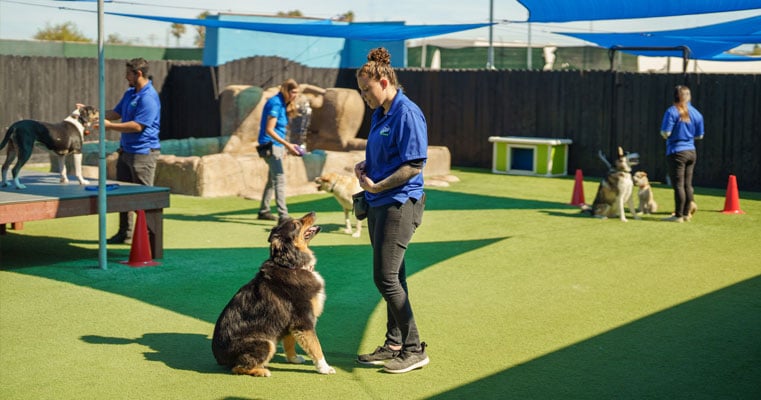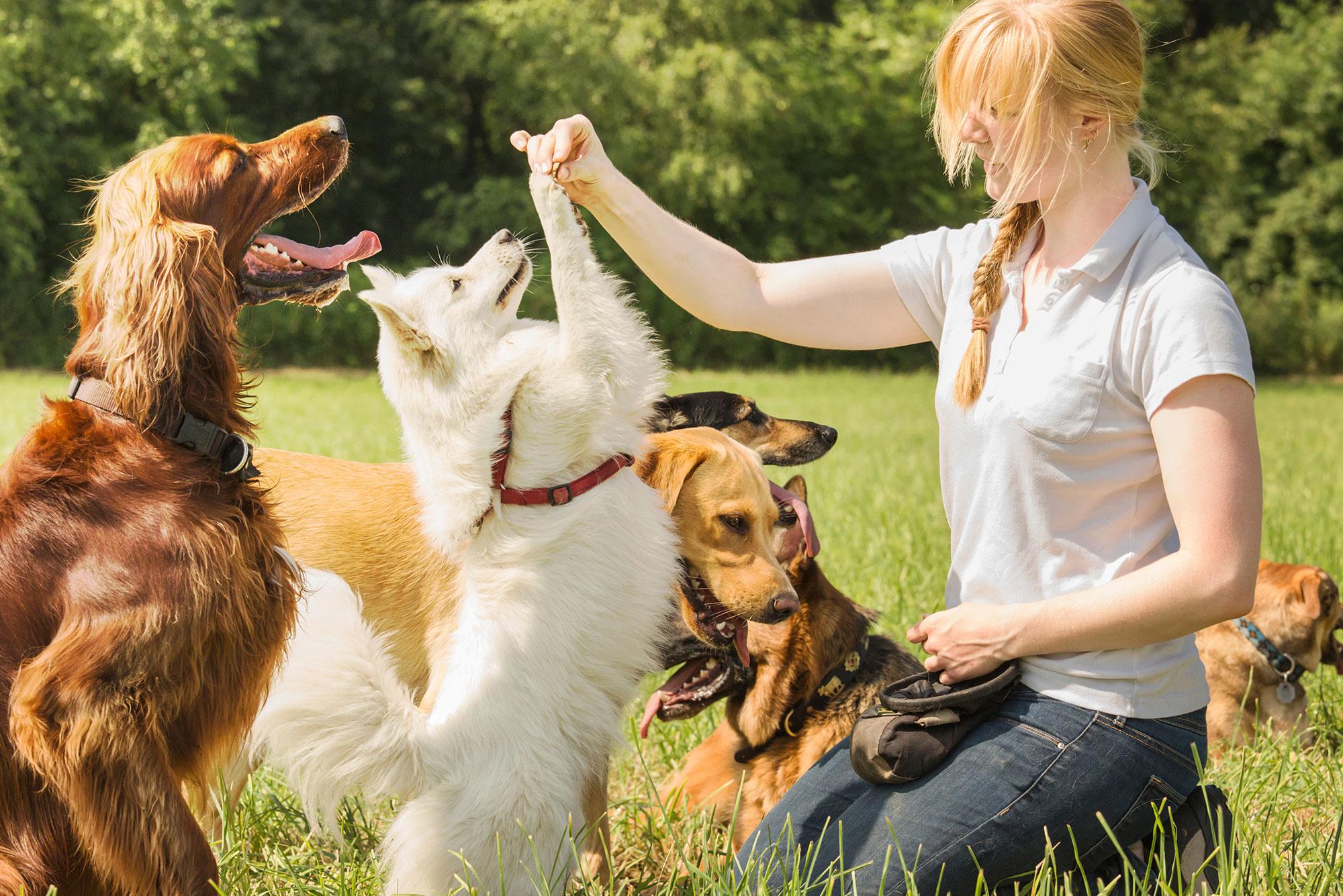Change Your Family Pet with These Expert Dog Training Tips
Change Your Family Pet with These Expert Dog Training Tips
Blog Article
Vital Tips for Effective Dog Training: An Overview for Animal Owners
Effective pet training is a diverse procedure that requires a strategic technique tailored to both the pet's temperament and the proprietor's goals. Recognizing exactly how to navigate these obstacles can significantly improve the training experience, ultimately changing the connection between proprietor and pet dog.
Comprehending Dog Behavior
Comprehending pet dog actions is important for reliable training and promoting a harmonious connection between pooches and their proprietors. dog training. Pets communicate mainly via body language, vocalizations, and actions, making it critical for proprietors to interpret these signals accurately.

Socialization plays a significant role in pet dog actions; direct exposure to different atmospheres, people, and other pets can dramatically influence a pet's character. Variables such as breed characteristics and specific character must direct training methods, as some types might have certain behavioral attributes that demand customized strategies. By recognizing these aspects, owners can develop a helpful environment that urges positive actions, causing successful training outcomes and a much deeper bond with their pets.
Developing Consistent Commands
Efficient communication with your dog begins with establishing consistent commands. This fundamental element of training is vital for fostering understanding between you and your family pet. Consistency in the commands you utilize makes sure that your pet dog can accurately link particular words or phrases with the wanted habits.
When selecting commands, select clear, distinctive words that are easy to differentiate and state from each other. Avoid utilizing similar-sounding commands that might confuse your pet. Utilizing "rest" and "stay" is suitable, however "rest" and "struck" might lead to misconceptions.
In addition, maintain the same tone and volume for each and every command. Dogs are sensitive to vocal hints, so differing your tone can develop confusion.
It is just as crucial to make certain that all member of the family get on the exact same page regarding the commands made use of. A united front in command use will certainly avoid mixed signals and enhance the discovering process.
Favorable Reinforcement Techniques
The power of favorable reinforcement in dog training depends on its ability to urge preferred behaviors via benefits and praise. This strategy is grounded in the concept that habits followed by beneficial outcomes are extra likely to be duplicated. By integrating positive reinforcement right into your training regimen, you can properly shape your pet's habits in a useful fashion.
To execute favorable reinforcement, it's necessary to determine what inspires your pet, whether it be deals with, playthings, or spoken appreciation. When your dog carries out a wanted action, such as resting on command, right away compensate them with a reward or love. This association in between the command and the positive result enhances their understanding.
It's important to timing the incentives appropriately; providing the reinforcement within secs of the desired habits aids your canine make the connection (dog training). Additionally, uniformity is vital-- guarantee that all relative make use of the exact same commands and incentive systems to avoid confusion

Gradually, you can decrease the regularity of deals with as your pet learns the actions, transitioning to commend or intermittent rewards. This technique not just promotes a solid bond between you and your canine however likewise advertises a positive learning environment, making training a delightful experience for both.
Socialization and Communication
Constantly exposing your canine to a variety of atmospheres, people, and other animals is critical for their social growth. Socializing needs to start early, ideally throughout the critical window of 3 to 14 weeks, when pups are most responsive to brand-new experiences. However, older pets can likewise take advantage of recurring socialization efforts.
Present your pet to various settings, such as parks, pet-friendly stores, and city locations. This direct exposure assists them adapt to various stimuli, lowering anxiety and anxiety feedbacks. Urge positive interactions with other canines and people, ensuring that these experiences are secure and controlled to cultivate self-confidence.
Use organized playdates with well-mannered pet dogs, as this can enhance your pet's social skills and educate them appropriate actions. Obedience classes and training sessions additionally supply excellent possibilities for socializing, enabling your dog to engage with others in a supervised atmosphere.
Display your dog's body movement throughout communications, as this will aid you gauge their comfort degree. Gradually raise exposure to more tough scenarios while making certain that each experience declares. A well-socialized dog is extra most likely to display balanced behavior, making them a happiness to have in any kind of setting.
Dealing With Typical Training Obstacles
Every pet dog owner will run into training challenges at some time, no matter their canine's age or socializing level. Determining typical concerns such as stubbornness, interruptions, and terror can help in developing efficient methods for renovation.

Disturbances throughout training sessions can thwart emphasis. To battle this, start training in a peaceful setting with very little stimulations. Slowly introduce diversions as the dog becomes more skilled in commands. Short, regular training sessions are also effective in maintaining attention.
Fearfulness can prevent web a dog's understanding procedure. Progressive desensitization to the source of anxiety, coupled with positive reinforcement, can aid relieve stress and anxiety. Persistence is crucial; never compel a pet dog into a scenario that triggers distress, as this may aggravate the problem.
Ultimately, understanding and addressing these typical difficulties with a structured approach will certainly promote a much more effective training experience, enhancing the bond in between pet and proprietor while visit this web-site promoting reliable knowing.
Conclusion
In recap, successful pet training depends on a comprehensive understanding of canine actions, the facility of consistent commands, and the application of favorable support methods. Socializing plays a vital role in creating well-adjusted family pets, while addressing typical training obstacles requires persistence and adaptability. By applying these vital approaches, family pet proprietors can foster a strong bond with their dogs and advertise preferable behaviors, eventually bring about a harmonious partnership between people and their canine friends.
Understanding canine habits is necessary see for reliable training and fostering an unified relationship between pooches and their owners.Socialization plays a substantial duty in canine habits; direct exposure to numerous atmospheres, individuals, and various other pets can significantly affect a pet dog's personality.The power of positive reinforcement in canine training lies in its capability to motivate desired behaviors with benefits and praise. By integrating favorable reinforcement right into your training regimen, you can successfully form your canine's behavior in a positive manner.
In recap, successful pet dog training counts on a detailed understanding of canine actions, the facility of regular commands, and the application of favorable support methods.
Report this page